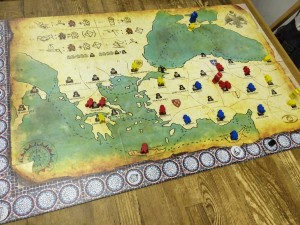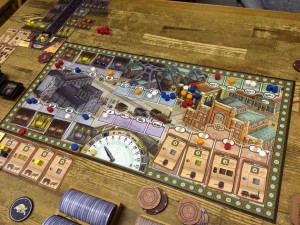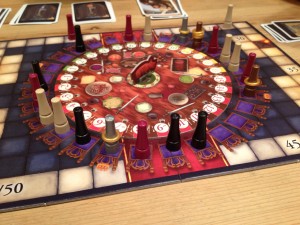Posted by James (admin) on 25th January 2014
As writing full reviews takes some time and I often play more games than I have time to review. As a result, there are many games that I play that don’t get reviewed for while, if at all. Therefore, this is the first of a new type of post where I will post a few quick thoughts about the games I have played. If there’s a game I mention that you’d specifically like a full review of, add a comment to let me know.
 Played: Byzantio Played: Byzantio
Byzantio is an area control game with a difference as each player only has a specific number of each of the different actions to use during the whole game so you need to ration them carefully. Players select their own objective cities.
I enjoyed this game, although it felt lighter because there was a bit more randomness than I expected, with the dice deciding several of the action types adding most of that. I don’t mind some randomness in a game, so it’ll be good to have that in mind when playing it again, and I hope it’s not too big a factor for my preferences. There are a few things I’d do to add more clarity to the board, but these are polish rather than fundamental.
Still, working out how to use your actions and how to try and disguise your intentions added some good gameplay.
Played with 3. |
|
 Played: Coal Baron Played: Coal Baron
Coal Baron is by the great team of Kramer and Kiesling (also called Glück Auf) which I previewed before Spiel in Essen. This in an excellent eurogame – plenty of elements to balance but plays in a short time too.
It felt like a lean and well-oiled game design made up of only the most necessary and important elements. There’s nothing revolutionary in the game design (although there is a nice small twist added to worker placement), but it impressed me with it’s elegance and how it delivered a tense, thoughtful game from such simple game mechanics.
Light enough for newer players, and enough decisions for experienced gamers wanting a short game. Very impressed.
Played with 4. |
James.
Tags: board game news, Board Games, board gaming, Byzantio, Coal Baron, Eggertspiele, Essen, Glück Auf, Ludicreations, Michael Kiesling, Spiel 13, Spiel 2013, Wolfgang Kramer
Posted in Board Games, Byzantio, Essen Spiel 13, Glück Auf, Played, Spiel 2013 | No Comments »
Posted by James (admin) on 13th June 2013
 The Palaces of Carrara first caught my attention because it’s a Eurogame by veterans Wolfgang Kramer and Michael Kiesling (Tikal, Tikal II, Asara). Also, the Palaces of Carrara has been nominated for the 2013 Spiel des Jahres Kennerspiel.
The Palaces of Carrara first caught my attention because it’s a Eurogame by veterans Wolfgang Kramer and Michael Kiesling (Tikal, Tikal II, Asara). Also, the Palaces of Carrara has been nominated for the 2013 Spiel des Jahres Kennerspiel.
Players buy coloured marble which they use to build buildings in the 6 cities. The player with the most victory points (VPs) at the end of the game is the winner. This may sound very ordinary, but there are several clever game mechanics that combine really well and deliver a tight and tense game.
On their turn, a player can either buy marble, build a building, or score.
Buying Marble
On the board is a rotating disc (split into 6 segments). Around the disc are 6 sets of prices for the different marble colours – white is most expensive, then yellow, then red, and so on. When buying marble, the player turns the wheel one section clockwise and draws marble blocks from the bag to bring the total on the wheel up to 11 (placing new blocks in the most expensive segment). The player can then buy any number of marble blocks but only from one single segment of the wheel. The costs are marked next to each segment and these get cheaper (even free) as blocks progress around the wheel. Read the rest of this entry »
Tags: Asara, board game news, Board Games, board gaming, Hans im Glück, Michael Kiesling, SdJ, Spiel des Jahres, The Palaces of Carrara, Tikal, Tikal II, Wolfgang Kramer, Z-Man Games
Posted in Board Game Review, Board Games, The Palaces of Carrara | No Comments »
Posted by James (admin) on 12th September 2012
 Artus is a game about King Arthur and the round table designed by Michael Kiesling and Wolfgang Kramer (the creators of great games such as Tikal, Tikal II and Asara). The board shows the round table with seats around the outside occupied by players’ knights, the princes and the king. The table shows points values ranging from -15 to +10 for each seat position. The crown on the table always points at the King, so when the King moves, the table turns which means the points for each chair change.
Artus is a game about King Arthur and the round table designed by Michael Kiesling and Wolfgang Kramer (the creators of great games such as Tikal, Tikal II and Asara). The board shows the round table with seats around the outside occupied by players’ knights, the princes and the king. The table shows points values ranging from -15 to +10 for each seat position. The crown on the table always points at the King, so when the King moves, the table turns which means the points for each chair change.
Each player has 22 cards (all will be played during the game) which are split into 3 decks and each player has the same: Knight cards move your own knights, King cards move the King/Princes, and scoring cards. Players start with 3 Knight and 3 King cards, but after their first turn, they can draw cards from any of their decks.
On their turn, players play any 2 of their 6 cards. Knight cards let the player move one of their knights a number of spaces within its range so a 3-6 Knight card lets you move one knight 3, 4, 5 or 6 spaces. Knights move clockwise apart from one card that lets you move one anti-clockwise. When a knight moves, the player scores points equal to the value of the chair (indicated by the table) that they vacate. If a knight moves to a chair already occupied by a knight then that knight gets displaced to the first empty chair anti-clockwise. Read the rest of this entry »
Tags: Artus, Asara, board game news, Board Games, board gaming, Michael Kiesling, Tikal, Tikal II, Wolfgang Kramer
Posted in Artus, Board Game Review, Board Games | No Comments »
 Played: Byzantio
Played: Byzantio Played: Coal Baron
Played: Coal Baron

 The Palaces of Carrara first caught my attention because it’s a Eurogame by veterans Wolfgang Kramer and Michael Kiesling (Tikal,
The Palaces of Carrara first caught my attention because it’s a Eurogame by veterans Wolfgang Kramer and Michael Kiesling (Tikal, 